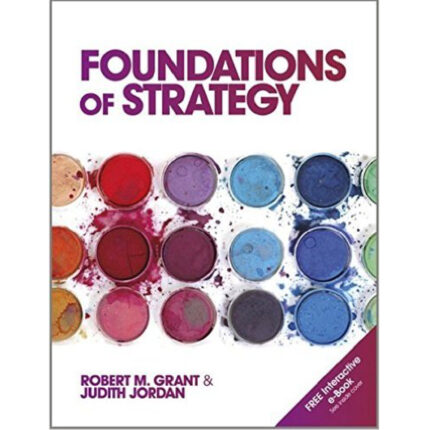Fundamentals Of Human Resource Management 7th Edition By Noe – Test Bank
Chapter 11 Separating and Retaining Employees Answer Key
True / False Questions
1. Generally, organizations encourage voluntary turnover among top performers because it is inexpensive.
FALSE
In general, organizations try to avoid the need for involuntary turnover and to minimize voluntary turnover, especially among top performers. Both kinds of turnover are costly.
AACSB: Analytical Thinking
Accessibility: Keyboard Navigation
Blooms: Remember
Learning Objective: 11-01 Distinguish between involuntary and voluntary turnover, and describe their effects on an organization.
Level of Difficulty: 1 Easy
Topic: Voluntary and Involuntary Turnover
2. Employees cannot sue employers for wrongful discharge if the employee was contracted under the employment-at-will doctrine.
FALSE
Historically, if an organization and an employee do not have a specific employment contract, the employer or employee may end the employment relationship at any time. This is the employment-at-will doctrine. This doctrine has eroded significantly, however. Employees who have been terminated sometimes sue their employers for wrongful discharge.
AACSB: Analytical Thinking
Accessibility: Keyboard Navigation
Blooms: Remember
Learning Objective: 11-01 Distinguish between involuntary and voluntary turnover, and describe their effects on an organization.
Level of Difficulty: 1 Easy
Topic: Voluntary and Involuntary Turnover
3. Outcome fairness involves the ends of a discipline process, while procedural and interactional justice focus on the means to those ends.
TRUE
Outcome fairness involves the ends of a discipline process, while procedural and interactional justice focus on the means to those ends. Not only is ethical behavior in accord with these principles, but research has also linked the last two categories of justice with employee satisfaction and productivity.
AACSB: Ethics
Accessibility: Keyboard Navigation
Blooms: Remember
Learning Objective: 11-02 Discuss how employees determine whether the organization treats them fairly.
Level of Difficulty: 1 Easy
Topic: The Role of Ethics in Human Resource Management
4. In procedural justice, the procedures should be consistent from one person to another, and the manager using them should suppress any personal biases.
TRUE
People’s perception of procedural justice is their judgment that fair methods were used to determine the consequences an employee receives. The procedures should be consistent from one person to another, and the manager using them should suppress any personal biases.
AACSB: Ethics
Accessibility: Keyboard Navigation
Blooms: Remember
Learning Objective: 11-02 Discuss how employees determine whether the organization treats them fairly.
Level of Difficulty: 1 Easy
Topic: The Role of Ethics in Human Resource Management
5. A disciplinary action meets the standards of outcome fairness if the manager explains to the employee how the action is procedurally just, treats the employee with dignity and respect, and empathizes with the employee’s feelings.
FALSE
A perception of interactional justice is a judgment that the organization carried out its actions in a way that took the employee’s feelings into account. A disciplinary action meets the standards of interactional justice if the manager explains to the employee how the action is procedurally just. The manager should listen to the employee. The manager should treat the employee with dignity and respect and should empathize with the employee’s feelings. Even when a manager discharges an employee for doing something wrong, the manager can speak politely and state the reasons for the action.
AACSB: Analytical Thinking
Accessibility: Keyboard Navigation
Blooms: Understand
Learning Objective: 11-02 Discuss how employees determine whether the organization treats them fairly.
Level of Difficulty: 2 Medium
Topic: Approaches to and Uses of Employee Discipline
6. Emily, a human resource specialist, has been asked to investigate complaints that an employee is bullying coworkers. Emily is obligated to protect this employee’s privacy by ensuring that any information gathered is relevant to the complaint.
TRUE
The courts have long protected individuals’ privacy in many situations. No matter how sensitively the organization gathers information leading to disciplinary actions, it should also consider privacy issues when deciding who will see the information. Measures for protecting employees’ privacy include ensuring that the information is relevant.
AACSB: Analytical Thinking
Accessibility: Keyboard Navigation
Blooms: Understand
Learning Objective: 11-03 Identify legal requirements for employee discipline.
Level of Difficulty: 2 Medium
Topic: Balancing Management’s and Employees’ Rights
7. In general, employers may conduct random searches of areas like desks, lockers, and toolboxes at any point in time without any justification to the employee.
FALSE
In general, random searches of areas such as desks, lockers, toolboxes, and communications such as e-mails are permissible, so long as the employer can justify that there is probable cause for the search and the organization has work rules that provide for searches.
AACSB: Analytical Thinking
Accessibility: Keyboard Navigation
Blooms: Remember
Learning Objective: 11-03 Identify legal requirements for employee discipline.
Level of Difficulty: 1 Easy
Topic: Balancing Management’s and Employees’ Rights
8. Under federal law, any U.S. employer that is planning layoffs must give employees 60 days’ notice of the layoffs.
FALSE
The Workers’ Adjustment Retraining and Notification Act requires that organizations with more than 100 employees give 60 days’ notice before any closing or layoff that will affect at least 50 full-time employees. Several states have similar laws, and the federal law contains a number of exemptions.
AACSB: Analytical Thinking
Accessibility: Keyboard Navigation
Blooms: Understand
Learning Objective: 11-03 Identify legal requirements for employee discipline.
Level of Difficulty: 2 Medium
Topic: Federal Laws Affecting Human Resource Management
9. The principles of justice convey that the organization must prepare for problems by establishing a formal discipline process in which the consequences become severe if the employee repeats the offense.
TRUE
The principles of justice suggest that the organization prepare for problems by establishing a formal discipline process in which the consequences become more serious if the employee repeats the offense.
AACSB: Ethics
Accessibility: Keyboard Navigation
Blooms: Remember
Learning Objective: 11-04 Summarize ways in which organizations can discipline employees fairly.
Level of Difficulty: 1 Easy
Topic: The Role of Ethics in Human Resource Management
10. Developing a formal discipline process is a prime responsibility of the human resource department.
TRUE
Creating a formal discipline process is a primary responsibility of the human resource department. The HR professional should consult with supervisors and managers to identify unacceptable behaviors and establish rules and consequences for violating the rules.
AACSB: Analytical Thinking
Accessibility: Keyboard Navigation
Blooms: Remember
Learning Objective: 11-04 Summarize ways in which organizations can discipline employees fairly.
Level of Difficulty: 1 Easy
Topic: Approaches to and Uses of Employee Discipline













Reviews
There are no reviews yet.